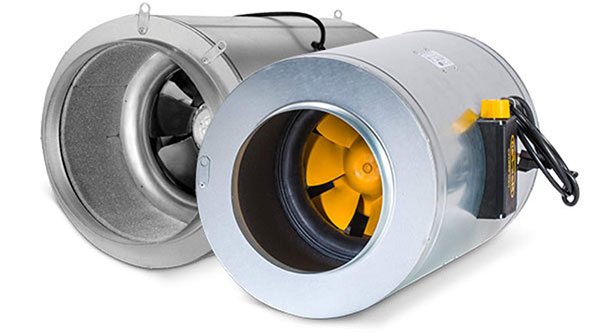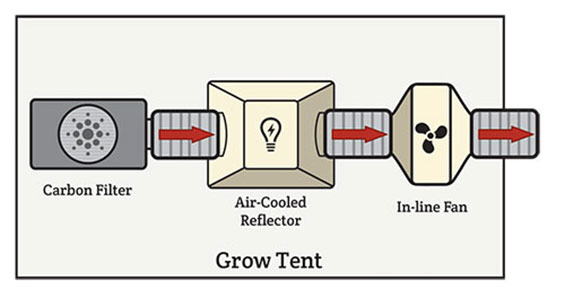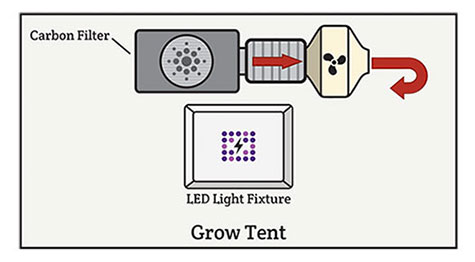Can Fan Q-Max Pro Series Inline Fan, 12" - 1709 CFM
Sign in to create a new quote.
Description
Can-Fan Q-Max Fans
Unrivaled airflow and whisper quiet operation.
Q-Max??? Pro Series Fans are a quiet line of fans that feature the familiar Max-Fan??? and Max-Fan??? Pro Series motors integrated with an acoustic foam liner in a muffler for maximum sound absorption. Unlike using most aftermarket mufflers, this integrated design muffles both the fan??™s intake and exhaust while also encapsulating the motor results in unrivaled airflow and whisper quiet operation. Q-Max??? fans also utilize built-in hang tabs for additional isolation and easy installation. Some models include a built-in 3 speed selector.
Details
- ETL Commercial/Industrial-rated
- Manufactured in Germany
- Built-in 3-speed controller
- Fan built inside muffler with acoustic foam insulation
- Muffles both intake and exhaust, does the job of 2 mufflers in much less space
- Built-in hang tabs to isolate vibrations
- Optimized mixed flow is extremely energy efficient
- Lower operational cost than traditional centrifugal fans
- 5-year warranty
- Available in sizes 6", 8", 10", 12"

Model Specifications
Can-Fan Q-Max 6??_ 400 CFM
| CFM: | 400 at 0wg |
| RPM: | 3322 |
| Maxx Watts: | 69 |
| Amps: | 0.62 |
| Weight: | 12.9 lbs. |
| Length: | 26.7??_ |
| Max. Height: | 9??_ |
| Blade Design: | Mixed Flow |
| Housing: | Galvanized |
| Inlet/Outlet | 6??_ |
Recommended Filters:
Exhaust
- Can-Lite 6??24 (speed 1)
- Can 66
- Can 50
Recirculate
- Can 33
- Can-Lite 6x16
- Can-lite 6x24 (speed 2,3)
Can-Fan Q-Max 8??_ 785 CFM
| CFM: | 785 at 0wg |
| RPM: | 3288 |
| Maxx Watts: | 186 |
| Amps: | 1.58 |
| Weight: | 16.9 lbs. |
| Length: | 26.7??_ |
| Max. Height: | 10.2??_ |
| Blade Design: | Mixed Flow |
| Housing: | Galvanized |
| Inlet/Outlet | 8??_ |
Recommended Filters:
Exhaust
- Can-Lite 8??40 (speed 1)
- Can 75 (speed 1,2)
- Can 100
- Can 125
Recirculate
- Can-Lite 8??25
- Can 66
- Can 50
- Can-Lite 8??40 (speed 2, 3)
- Can 75 (speed 3)
Can-Fan Q-Max 10??_ 1019 CFM
| CFM: | 1019 at 0wg |
| RPM: | 3174 |
| Maxx Watts: | 231 |
| Amps: | 1.95 |
| Weight: | 22 lbs. |
| Length: | 27??_ |
| Max. Height: | 12.75??_ |
| Blade Design: | Mixed Flow |
| Housing: | Galvanized |
| Inlet/Outlet | 10??_ |
Recommended Filters:
Exhaust
- Can-Lite 10??40 (speed 1)
- Can 100 (speed 1)
- Can 125
- Can 150
Recirculate
- Can 50
- Can 75
- Can-lite 10x40 (speed 2,3)
Can-Fan Q-Max 12??_ 1709 CFM
| CFM: | 1708 at 0wg |
| RPM: | 3385 |
| Maxx Watts: | 489* |
| Amps: | 4.5 |
| Weight: | 33 lbs. |
| Length: | 27??_ |
| Max. Height: | 14.2 |
| Blade Design: | Mixed Flow |
| Housing: | Galvanized |
| Inlet/Outlet | 12??_ |
Recommended Filters:
Recirculate
- Can 75
- Can 100
- Can 12x40
- Can 125
- Can 150
Determining your requirement - Exhaust vs Recirculating (Scrubbing)
You will need to determine whether or not you are exhausting (going from a contaminated environment to a sterile environment in only a single pass through the filter) or recirculating, aka ???scrubbing??? (exhausting the system back into the contaminated space).
Exhaust
In an exhaust setting the air only passes through the filter one time so it is imperative that we remove as close to 100% of the contaminate as possible with that one chance. This requires that the contaminant have a certain time in contact with the carbon in order to be fully absorbed. Our filters are marked with both exhaust and recirculating ratings for just this reason. If you are using this system to exhaust, DO NOT exceed the exhaust rating for the filter, the more this rating is exceeded the less contaminant will be adsorbed because the two will not have enough contact time for adsorption to fully take place.

Recirculating
In a recirculating system, the contact time is not such a crucial number as we are taking contaminated air, filtering it, and releasing it back into what is typically and constantly decontaminated environment. It is for this reason that it is not necessary to remove 100% of the contaminant in a single pass. Instead, we double the exhaust rating which will reduce the contact time, the goal here is to still remove a large portion of the contaminant but to get raise the cycle rate of air through the filter above the rate of emission from the source. Now, instead of removing 99.9% of the contaminant in a single pass, we are getting closer to 60% but we are getting twice as many cycles through the filter in the same amount of time and over time, reducing the overall build-up of the contaminant in the environment.

Sizing Your Space
Once you??™ve determined the type of system you need, it??™s time to size your space.
Typically for exhaust we recommend a simple length x width x height /3 calculation. This will give you the amount of air (cubic feet per minute, CFM) that you will need to move to properly ventilate your space allowing for a three-minute air exchange (all the air in the space is exchanged for fresh air every three minutes). This is the number you will match your filter to.
Example:
Room size: 10??™x12??™x8??™ (960 cubic feet)
960 cubic feet / 3 minutes = 320CFM (Minimum recommended CFM to exchange the air every 3 minutes)
For recirculating systems, you can use the same length x width x height but divide by 1.5. This will give you a high cycle rate while still ensuring the removal of a majority of contaminants with each pass through the filter.

